Written by Chris
Sani Village outside of Coca, Ecuador – After a three-hour boat and canoe ride into the Amazon, we met with our indigenous guide for our five-day tour there:
Me: “Did you just see that?”
Expert Guide: “What? That white bat?”
Me: “Yeah, what was that?”
Expert Guide: “I don’t know; never seen that before.”
Uh oh. I came all the way out here and our “Expert Guide” couldn’t even identify the very first thing we saw. I was a bit concerned at first, but I soon realized that this episode spoke not to the experience of our guide but rather to the enormous amount of biodiversity found here in the Amazon. Our guide, Fredy, was born and raised in the Amazon jungle as a part of the indigenous Kichwa Tribe in the Sani Community and he was indeed an expert on the vast majority of the plants and animals found there. And he is still finding out new things.
Mindy and I arrived at the Sani Lodge for our guided stay earlier this week. The lodge is run by the Sani Community, a native tribe that has settled along the Napo River in the Amazon Jungle in Eastern Ecuador. They are one of many tribes struggling to exist here in the modern world, and this lodge has been an excellent way for them to support themselves without overly exploiting the rich natural resources that they oversee.
We opted for the camping stay rather than the private lodges and we were very pleased. We ended up as part of a group with about 6 other visitors (4 from USA and 2 from Canada) and we all had a great time getting to know each other over the course of the week. Facilities were basic, but they were luxurious by camping standards; running water, flush toilets, and tents with mattresses up on covered platforms. We had several guided excursions each day over land and water. Meals and snacks were provided by the lodge’s excellent kitchen staff and our guide joined us at meals to share stories and experiences from his life in the community. We could not have been more pleased with our stay and the service provided by the staff there.
Most of our days followed a similar format. We woke at 5 am for our canoe ride to the lodge where we were served breakfast. Afterwards, we would go out for an excursion to catch some early-morning happenings, we would have a boxed lunch on the trail, and follow it with some more activities in the afternoon. We then would head back to the lodge for a bit of a siesta before dinner and on a few of the evenings we would head out after dark to see all the strange things that come out at night.
Hiking with our guides was a fantastic experience. We were constantly happening upon new plants and animals, and they were excellent at explaining everything. They pointed out all the plants the uses they have for them; types of wood for construction, palms for basket weaving and thatched roofs, fruits and nuts and roots for food, and, my favorite, the medicinal plants. We saw the plants they used to heal burns and cuts and broken bones, to kill insect parasites, stop upset stomach and diarrhea, cure malaria, make a muscle-relaxant for their poison darts, and to remove warts (which I was able to use with great success on a finger wart of my own). They were great at spotting all the nearby animals and insects, they could imitate the calls and cries to lure them closer, and they could locate and identify the far-off ones by picking out their sounds from among the noises of the jungle. But our favorite by far, was when the guides would stop and listen for a bit and the urgently wave us forward while whispering, “monkey, monkey, monkey!“.
Shortly after the start of our first hike, our guides started shushing us and running off into the forest where we watched as a troop (yes, that’s a group of monkeys) of Wooly monkeys crashed through the canopy above us followed by several more graceful Howler monkeys. The next day, we were paddling canoes down a quiet channel and watched some more Howler monkeys scamper through the trees across the water. One, agitated by our presence, stared at us and took a nice dump into the water right in front of our canoe. And on our last day, as we were canoeing down another channel, we were overtaken by over 100 Squirrel monkeys racing past us through the trees on both sides with a few Capuchin monkeys (like Marcel from Friends) thrown in for good measure. We saw a total of seven different types of monkeys over the course of the week: Wooly monkey, Howler monkey, Tamarin monkey, Night monkey, Pygmy Marmoset monkey, Squirrel monkey, and Capuchin monkey.
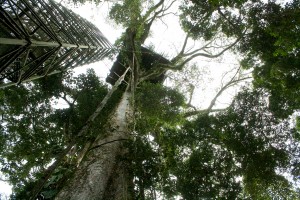
This canopy tower, built on a 50m tall kapok tree, gave a thrilling view of the vast jungle and the amazing wildlife at the top
One day, after we were all monkeyed out, we took a hike to a canopy tower that the tribe had set up. It consisted of a platform installed on top of a 50m (164 ft.) high Kapok tree that we reached via a metal scaffolding. After checking out the top of the forest we headed over to the Sani Village where we were able to meet many people from the tribe. They cooked us an excellent traditional lunch consisting of fish grilled in banana leaf, grilled bananas, jungle potatoes, and a local beverage called Chicha which is made from yuca (a potato-like tuber) which is boiled and fermented with saliva (though our guide assured us that the batch made for us was not made in the traditional saliva-y way). The grand finale was a large beetle grub for desert. I was coaxed into eating one grilled first (amazingly delicious, tasted like grilled ham) but then, in a temporary lapse of sanity, I went on to chow down on a pulsating, pincer-chomping, live larvae. Stay tuned for some video of that stomach-churning mess.
The insects in the rain forest did not disappoint, either. It was a lot of fun watching the leaf cutter ants toting their spoils along the superhighways they forged, but not so fun constantly batting away the mosquitos and flys that were constantly after any patch of skin they could find. Every giant spider web we saw along the trail seemed to have a different spiky, colorful, humongous type of spider in the center of it. I discovered early on to be more vigilant for these guys after I whipped my poncho out of my bag, threw it on, and looked down at a big hairy spider about 3 inches across sitting on my chest. After a few seconds, I unfroze from the shock and batted it to the ground. Despite my best efforts, Mindy got a glimpse of the crippled beast on the ground and let out a scream so that the whole group ran over and got a good look at the thing. But that night, I found out that this was just a warm-up.
We headed out for a night hike and, in the Amazon, this is where all the creatures from your worst nightmares are brought to life. Every few steps or so we would find some new horror to marvel at. Every creature out there was a humongous version of what you’re normally used to, so I’ll consider that particular descriptor implied from here forward. There were spiky grasshoppers, centipedes/millipedes, toads that can eat a rat, and all possible manner of spider: tarantulas the size of your fist, scorpion spiders with huge folded arms, jumping wolf spiders, social spiders with thousands working together on a dog-sized web nest, and many very colorful probably very poisonous miscellaneous spiders.
When dawn finally came again, there was so much more to see. We visited a spot on the riverbank where close to 50 parrots were packed together eating clay to cleanse their systems. We saw a 3 meter boa constrictor in a tree waiting for prey, but we missed out on the giant anacondas that roam around. There were more birds everywhere than we could shake a camera at: Harpie eagle, parrots, toucan, “stinky turkeys” (looks like one but locals won’t eat them), “car alarm bird” (sounds like one), “cooking bird” (sounds like boiling water), raptors that eat the heads off snakes, and a “water drop” bird that made an amazing sound. Unfortunately, the guide gave us the native names for a lot of these and so I had to make up an English version.
It was a great week in the jungle and I would certainly do it again. The group that we shared it with were all fascinating people and made the trip much more fun. I was actually shocked with the amount of things we were able to see in such a short time, and I am glad that the Sani Tribe is working so hard to preserve things in the forest the way that they are. The one thing that disappointed me about the trip was that I didn’t get to see a jaguar and anaconda fight to the death like I had hoped. I guess there’s always next time…
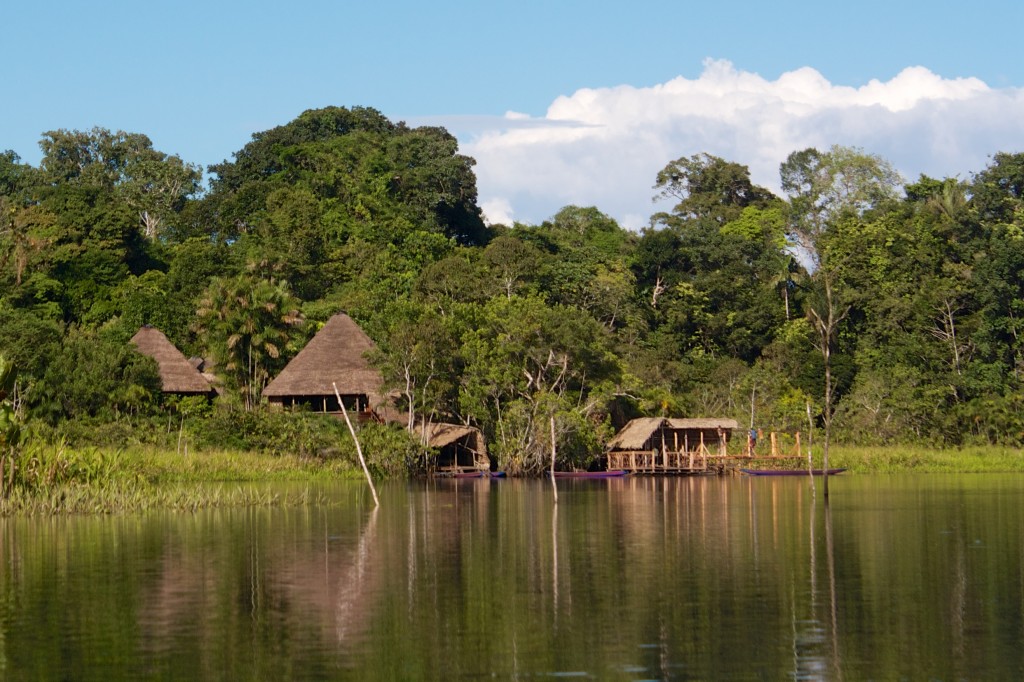
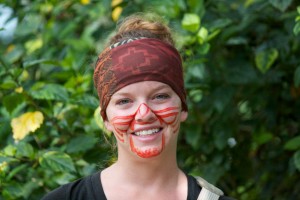
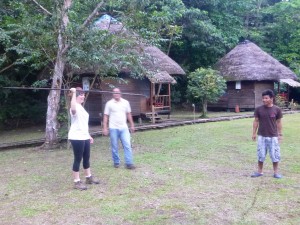
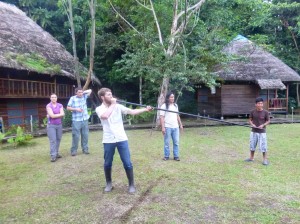
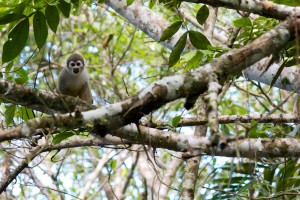
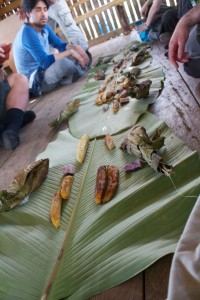
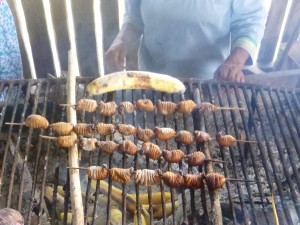
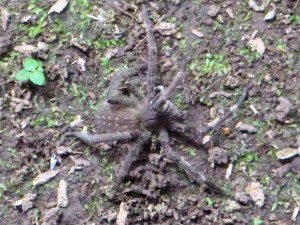
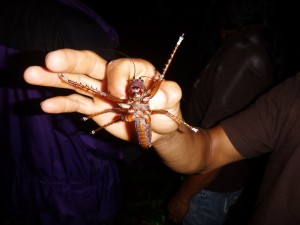
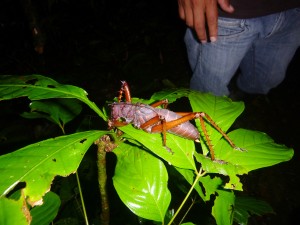
Well the spiders decided where my next trip won’t be. Glad it went well.
Pingback: Weird plants | Big Folly
Pingback: To be prepared … or not to be | Big Folly
Pingback: Moving through the Amazon | Big Folly